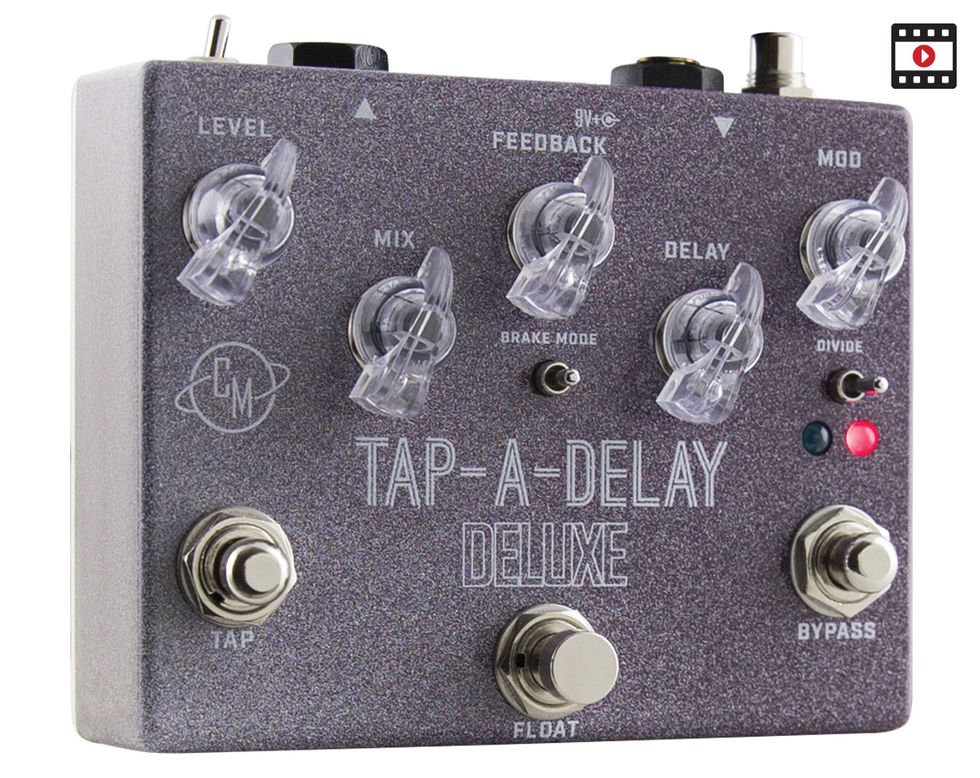Gibson SG into Plexi-type amp set semi-clean
0:00 – Effect off
Through the Mod(ulation) settings
0:11 – Position 1: no modulation. Moderate Mix, Delay and Feedback settings.
0:21 onward, progressively more intense modulation.
2:01 – Float: switch left, then switch right.
3:05 – Brake Mode: switch left, then middle, then right.
Delay is among the most creative realms in stompbox design. Enabled by ever-increasing digital horsepower, adventurous makers have adopted an “if you can dream it, do it” approach, building mega-featured pedals that exponentially increase musical possibilities.
Cusack Music, of Holland, Michigan, already has a reputation for tap-enabled effects, but they’ve upped the interactivity ante with the new Tap-A-Delay Deluxe. It’s loaded with eleven knobs, buttons and switches in total—many of them multi-function—and squeezed into an impressively compact 4.7" x 3.69" x 1.37" die-cast metal stomp that requires just 30 mA of external 9V DC power via a standard center-negative input.
The foundation of the Tap-A-Delay Deluxe is a 750 ms digital delay. But rather than the crisp, clinical echoes of the traditional studio digital delay, the Deluxe is voiced for slightly dirty and gritty repeats that sound studiously analog. And that’s before you start morphing things with the multi-mode mod (modulation) switch. Add to this the ability to create loop-like background repeats, tempo acceleration or deceleration, oscillating feedback, and much more—all on the fly—and you start to grasp this pedal’s full potential.
on the market.
Mission Control
The functions at the heart of the Tap-A-Delay Deluxe—level, mix, feedback, and delay time—are controlled via translucent mini-chicken-head knobs. An 8-position mod switch adds progressively more intense tape-like modulation to the repeats, and is pretty wild at its two most extreme settings. The bypass footswitch turns it all on or off (but also does more, as we’ll see). If you stray no further than these functions, you’ll get a lot out of this versatile delay. But stray you almost certainly will.
You step on the tap footswitch twice to set delay tempo (though at least four taps improves accuracy, in my experience), which can be transformed into eighth-note, dotted-eighth-note, or quarter-note divisions, depending on where you set the divide mini-toggle. The float footswitch, meanwhile, induces oscillation feedback or freezes the repeats depending on where you set the float input mini-toggle.
Ratings
Pros:Excellent analog-voiced delay sounds are the foundation for creativity-sparking features.
Cons:
Diminutive dimensions make switch selection challenging, especially on a dark stage.
Tones:
Ease of Use:
Build/Design:
Value:
Street:
$269
Cusack Tap-A-Delay Deluxe
cusackmusic.com
Still, there’s more. Though it’s concealed as the tap footswitch’s second function, brake mode performs three nifty effects depending on how you set the 3-way brake mode mini-toggle. Holding down the tap button alternately slows down or speeds up the repeat time. Releasing the button, however, has a different effect depending on where you set the brake mode switch. In mode 1 the delay stays at the tempo you have at release. In mode 2 it snaps back to the tempo you had before you initiated brake mode. And in mode 3 it slides gradually back to the original tempo. Stomping both bypass and tap together determines whether the tempo accelerates or decelerates upon engagement.
If these deeper functions sound slightly mind-boggling at first, the functions all perform logically and intuitively once you understand where to find them. The status of most functions is indicated by the color or pulse of its associated LED. There’s also an internal trim pot that rolls off highs in the repeats, as well as an RCA jack to connect an external tap switch. It’s all extremely well thought-out, and the only hitch I can see might be stomping accurately amid all the buttons—especially on a dark stage.
Major Delay
I explored Tap-A-Delay Deluxe’s tonalities with a Stratocaster and a Les Paul, through a Friedman Small Box head and 2x12 cab, and a 3 Monkeys Orangutan Jr. 1x12 combo. Even before diving into the modulation settings, I found the Tap-A-Delay Deluxe’s repeats appealingly warm, granular, and decidedly analog sounding, but not gnarly to the point of losing clarity or definition. Add a little modulation to the base tone, and the Deluxe ranks alongside any of the better digital tape-delay emulators on the market. Indeed, with eyes closed I was homing in on some of my favorite Space Echo- and Echoplex-inspired moods.
Start flipping toggles and stepping on bonus footswitches, though, and the Tap-A-Delay Deluxe takes to the stratosphere. I was most enamored with the possibilities of cycling a looped segment by holding float while riffing over the top, which becomes absolutely hypnotic. But the freakish soundscapes enabled by the various brake mode settings were also tons of fun. Add in the more extreme modulation settings and this pedal becomes a wild texturalist’s dream come true.
The Verdict
Whether you just need a reliable, great-sounding pedal to take you from tape-like slapback to moody atmospherics, or plan to utilize the full creative potential of its multi-faceted interactivity, the Tap-A-Delay Deluxe is a 21st century delay worthy of deep exploration. Just a little time spent discovering its bonus features and on-the-fly controllability pays unique, even stunning, sonic dividends, making the $269 price tag quite reasonable.
Watch the Review Demo:








![Rig Rundown: Russian Circles’ Mike Sullivan [2025]](https://www.premierguitar.com/media-library/youtube.jpg?id=62303631&width=1245&height=700&quality=70&coordinates=0%2C0%2C0%2C0)

















